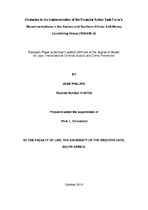| dc.description.abstract | Money laundering is a global problem that has adverse effects on both the developed and developing countries. If unchecked, it accelerates crime and criminal activities, affects the economy, undermines the integrity of financial markets, undermines the legitimate private sector, causes loss of revenue, poses security threats to privatisation efforts and brings about reputational risks as well as social costs.1 Given the transnational and cross-border nature of money laundering, the fight against it is global. This is why in 1989 the G72 countries decided to set up the FATF3 as a global standard-setting body for Anti-Money Laundering (AML) and combating of terrorist financing (CFT). The FATF has since developed standards for countries across the globe to adopt so as to facilitate this global fight. The standards are in the form of recommendations, and so far there are Forty Recommendations on money laundering (hereafter referred so as the Recommendations), Eight Special Recommendations on CFT, and a Ninth Special Recommendation on cash-couriers. In order to enhance its work and the adoption of its Recommendations, the FATF has also facilitated the establishment of FATF- styled regional bodies (hereinafter referred to as FSRBs) across the world. One such group is ESAAMLG, which was established in 1999. Its mandate is to coordinate and guide its member countries in the implementation of the Recommendations and guidelines. Currently, it has 15 member countries.8 Over the first ten years of its existence, among other things, ESAAMLG has through its members, achieved the following in its mandate: all members except Uganda have enacted AML legislation and some have set up structures that are essential for the implementation of the Recommendations Despite the above-mentioned achievements, the overall implementation of the Recommendations has been generally slow and low. Most of the member countries have not yet enforced their enacted AML legislation as evidenced by low rate of money laundering prosecutions in the region. Some have not yet established financial intelligence Units (FIUs) nor ratified or domesticated important AML related international legal instruments, let alone train personnel adequately. The international instruments comprise the 2000 United Nations Convention against Transnational Organised Crime (Palermo Convention) and the1988 United Nations Convention against Illicit Traffic in Narcotic Drugs and Psychotropic Substances (Vienna Convention). There are also inordinate delays in the passing of AML legislation as well as the amendment of other domestic legislation, which is necessary in order to harmonise such laws with the AML standards. This gives rise to unevenness, disconnectedness and time variability in the implementation of the Recommendations among the member countries. The main question this paper seeks to answer is this: Are there obstacles to the implementation of the Recommendations in Eastern and Southern Africa? | en_US |

